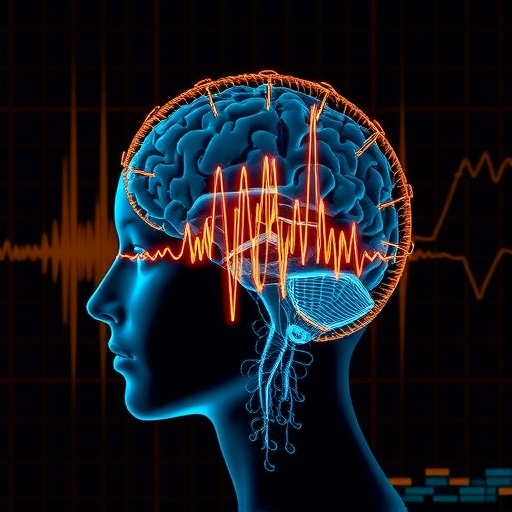Recent advancements in the interdisciplinary field of neuroscience and mental health have unveiled promising avenues for evaluating and understanding depression through the lens of EEG (electroencephalogram) insights. The exploration conducted by Chen, Zhao, and Cai leads to a groundbreaking concept termed “EEG Internal Volatility,” which provides a unique view into the complex dynamics underlying depressive disorders. By delving into the non-linear dynamical analysis of EEG data, this research presents a sophisticated framework for gauging internal cognitive states, thereby offering significant implications for both clinical evaluations and therapeutic interventions.
At its core, EEG is a well-established technique that records electrical activity of the brain and has been pivotal in diagnosing several neurological conditions. However, its potential in mental health assessment, particularly in understanding mood disorders, has gained significant traction in recent years. The study by Chen et al. emphasizes that traditional assessments may overlook the intricate temporal patterns of brain wave activities associated with depression. This oversight necessitates an evolved perspective on how EEG can be utilized for deeper diagnostic comprehension rather than mere surface-level observation.
The key innovation presented in the paper is the concept of “Internal Volatility,” which refers to the inherent fluctuations observed in EEG readings over time. This notion contrasts sharply with previous methods that focused predominantly on static measures. By analyzing the dynamic characteristics of brain signals, the researchers propose that fluctuations can serve as indicators of emotional states, specifically in relation to depressive episodes. This departure from the established paradigms considerably enhances the potential of EEG as a diagnostic tool, which may resonate well in clinical settings.
Utilizing non-linear dynamic analysis techniques, Chen and colleagues dissociate the relevance of chaotic behavior in brain electrical activities. Traditional linear models may not adequately capture the complex interactions happening in neural circuits, particularly under depressive conditions. Hence, fractal and entropy-based analyses are employed to decipher the underlying dynamics that illustrate the turbulent nature of depressive states. Through advanced mathematical modeling, these fluctuations are quantified, yielding reproducible markers that clinicians can use for better identifying and tracking the evolution of depression in individuals.
A particularly compelling takeaway from this innovative study is the correlation identified between EEG Internal Volatility and the subjective experiences of depression in patients. By involving a diverse cohort of subjects, the researchers meticulously measured changes in volatility alongside established psychological assessments. The convergence of findings across these methods provides not only validation for the EEG assessments but also strengthens the argument for integrating this technology more widely in therapeutic contexts.
Furthermore, the implications of EEG Internal Volatility extend beyond mere diagnosis. The ability to monitor fluctuations in real-time presents exciting opportunities for personalized treatment approaches. Patients undergoing therapy can be assessed continuously, allowing clinicians to adapt interventions based on the immediate brain dynamics rather than relying solely on intermittent evaluations. This approach fosters a more responsive strategy that could potentially enhance therapeutic outcomes for individuals with depression.
Deploying EEG technology in clinical practices also raises important considerations regarding accessibility and training. While many healthcare settings have access to sophisticated neuroimaging equipment, the need for specialized expertise to interpret EEG data holistically cannot be understated. Therefore, establishing standardized protocols and training modules will be crucial in rolling out this advanced diagnostic approach for wider use among mental health professionals.
Moreover, the research introduces a dialogue regarding ethical implications and the need for cautious interpretation of EEG data. As with any technology that uncovers intrinsic human conditions, there is a responsibility to respect privacy, ensure informed consent, and address the complexities of data handling. Consequently, developing ethical guidelines tailored to the use of EEG insights in mental health analysis will be vital as the field continues to advance.
Importantly, the findings of Chen et al. open a gateway to future research avenues that could refine the understanding of not just depression, but potentially other mood disorders, such as anxiety or bipolar disorder. By exploring how different emotional states might correlate with measured EEG fluctuations, further insights can emerge that will enrich the field of psychiatric neurology, leading to enhanced care strategies tailored to individual needs.
In conclusion, the research spearheaded by Chen, Zhao, and Cai represents a significant leap towards integrating advanced techniques in EEG analysis with mental health assessment and treatment. With further validation, the concept of EEG Internal Volatility could redefine diagnostic frameworks in psychiatric care, ultimately making strides toward more precise and effective strategies for supporting individuals with depression. As the scientific community continues to unveil the complexities of the human brain, this study epitomizes the critical intersection of technology and mental health, leaving behind a trail of potential that could transform the landscape of psychological evaluation.
The exploration of EEG Internal Volatility not only enriches our understanding of depression but also surfaces broader ethical and practical questions about the applicability and interpretation of neurodiagnostic data. Moving forward, it is imperative that both researchers and practitioners engage collaboratively in discussions mirroring the rapidly evolving nature of this field. The elevation of EEG beyond traditional boundaries could well mark a new era in mental health diagnostics and intervention.
In essence, the promising insights from this research beckon a call to embrace innovative methodologies and make scientifically-informed decisions for the future of mental healthcare, delivering hope to millions suffering from depression worldwide.
Subject of Research: EEG Internal Volatility in the Evaluation of Depression
Article Title: EEG Internal Volatility: A New Insight for Depression Evaluation via Nonlinear Dynamic Analysis
Article References:
Chen, F., Zhao, L., Cai, Z. et al. EEG Internal Volatility: A New Insight for Depression Evaluation via Nonlinear Dynamic Analysis.
J. Med. Biol. Eng. 45, 166–176 (2025). https://doi.org/10.1007/s40846-025-00939-2
Image Credits: AI Generated
DOI: https://doi.org/10.1007/s40846-025-00939-2
Keywords: EEG, Internal Volatility, Depression Evaluation, Nonlinear Dynamics, Mental Health




